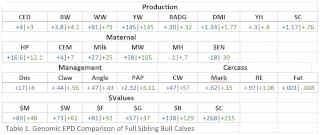Table 1 is a comparison of full sibling bull (twin) calves that represent genetics out of the same sire and dam that have been DNA tested and that information utilized in the calculation of their EPDs.

In this comparison, we can see these bulls are similar in CED, WW, YW, and Milk for some examples. In contrast, we can see where these bulls differ in SC, MW, and Doc. The differences and similarities are echoed through the comparisons of the bulls’ $Values. Calf #1 displays opportunities to be the better selection when looking to retain females ($M). On the other hand, if retaining ownership of calves through the finishing period and marketing as a live animal, Calf #2 would produce offspring with higher profit potential.
Genomic-enhanced EPDs are the best estimate of an animal’s genetic value as a parent, combining all available sources of information. This permits higher accuracies for EPDs on younger animals. With the inclusion of genomics, we can better understand how an offspring relates to its parents from trait to trait, which creates an opening for increased certainty that mating selections will progress towards breeding objectives more rapidly and as intended.
Interviews with the authors of BeefWatch newsletter articles become available throughout the month of publication and are accessible at https://go.unl.edu/podcast.
Source : unl.edu